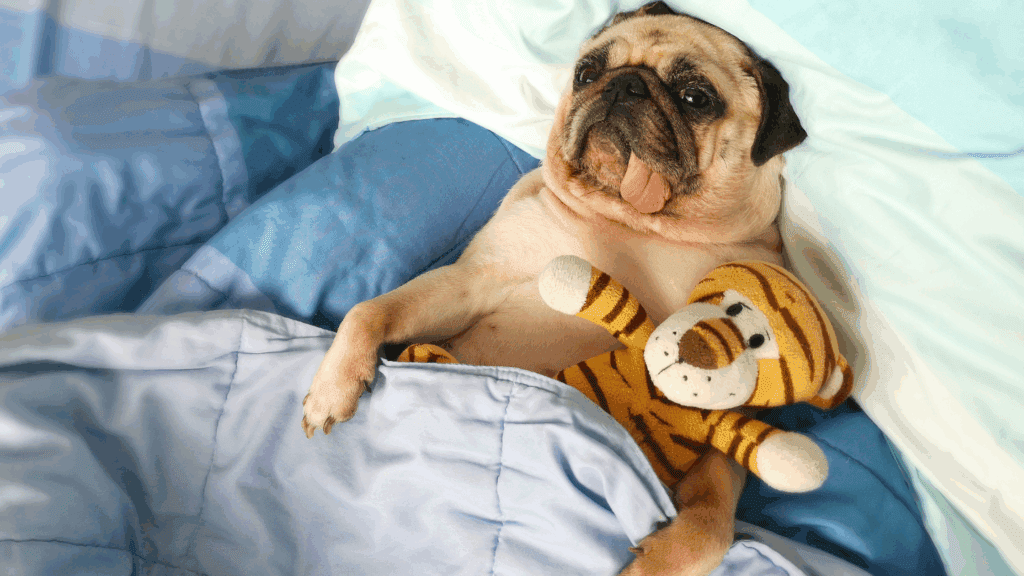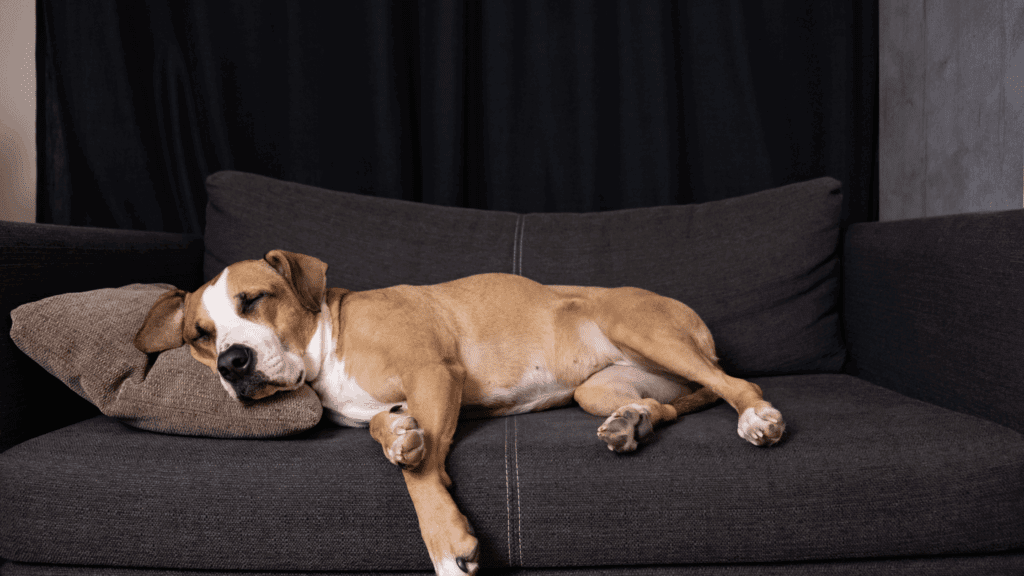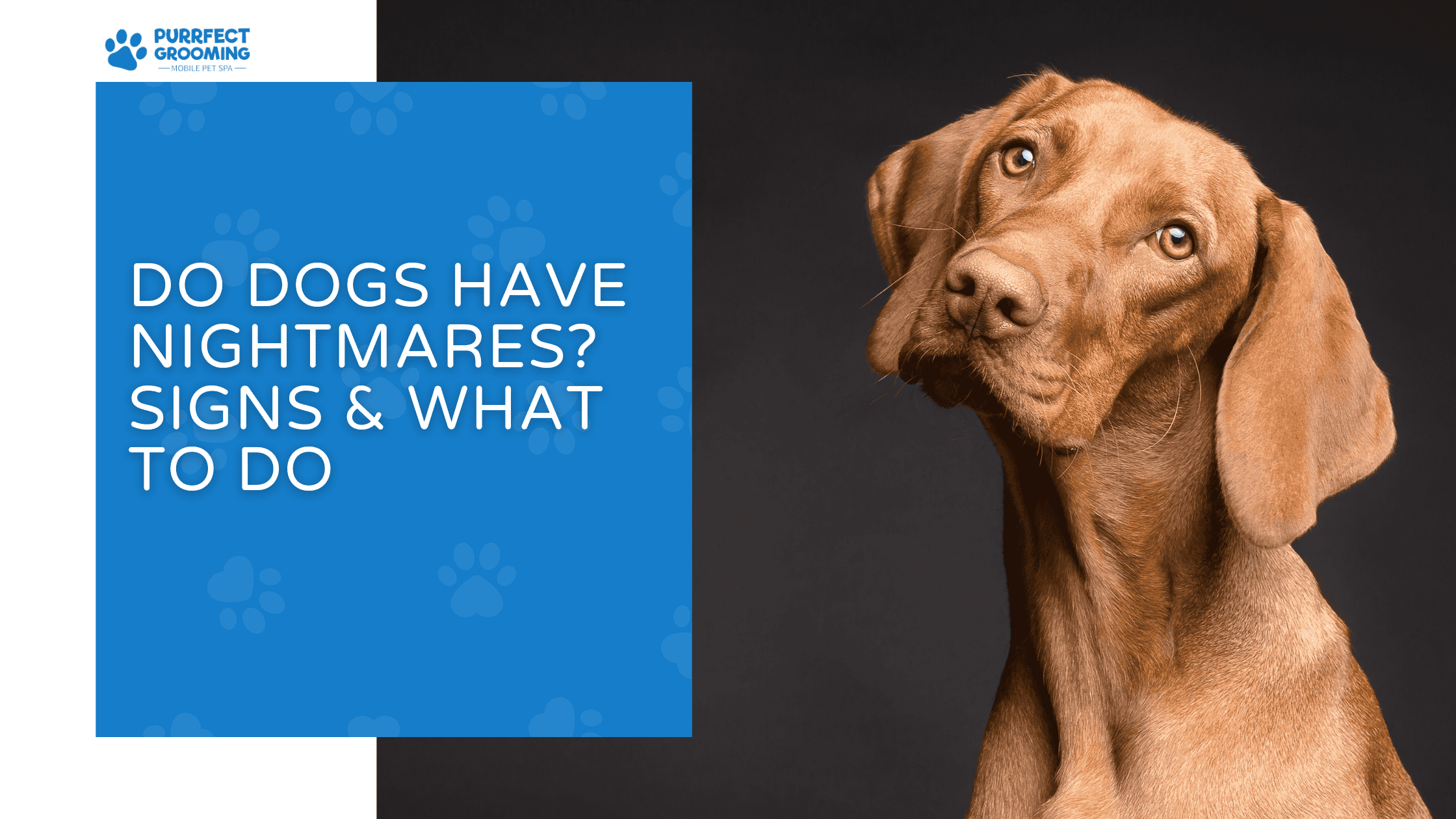Do Dogs Have Nightmares? Signs & What to Do
Ever seen your pup twitching, whimpering, or paddling in their sleep and wondered—do dogs have nightmares? If so, you’re not alone. It’s a question many pet parents ask after witnessing their furry companions seem restless or even distressed during slumber. The concern is valid—what if it’s more than just a dream?
Fact: According to a 2017 study by Harvard-affiliated neuropsychologist Dr. Deirdre Barrett, dogs not only dream but likely dream about their human families and daily activities .
In this blog, we’ll explore:
- The sleep cycles of dogs and how dreams form
- The difference between regular dreams, nightmares, night terrors, and REM sleep behavior disorder
- What you can do (and should avoid doing) to help your dog sleep better
- When it’s time to see a vet

Understanding Dog Sleep & Dreams
Dogs experience a sleep structure similar to humans, moving between different phases including light sleep, deep sleep, and REM (Rapid Eye Movement) sleep. REM sleep is especially significant because it is during this phase that dreaming occurs. During REM, dogs often exhibit physical signs such as paw twitching, soft vocalizations, and facial movements—indicating they’re actively dreaming. Puppies and older dogs tend to spend more time in REM sleep, possibly due to higher levels of mental processing and memory consolidation. The presence of these dream phases in canine sleep cycles supports the theory that dogs not only dream but may also experience nightmares.
The duration and quality of canine sleep cycles vary based on breed, age, and daily activity levels. Small breeds usually enter REM sleep faster and more frequently than larger breeds. While adult dogs typically sleep for about 12–14 hours a day, puppies and seniors might sleep even longer. Adequate REM sleep is essential for a dog’s emotional balance and cognitive development. Interruptions in these cycles can lead to behavioral changes and increased anxiety. Understanding the nuances of canine sleep cycles is the first step in interpreting the behaviors we observe during our dog’s rest.
1. Sleep Stages in Dogs
Just like humans, dogs cycle through different sleep phases:
- Non-REM Sleep: Light sleep where physical restoration happens
- REM Sleep: Deep sleep linked to dreaming and memory consolidation
During REM, you’ll often see your dog:
- Twitching or wagging their tail
- Moving their paws as if running
- Whimpering or softly barking
This phase is critical to their mental health—interrupting it may impact emotional balance and learning.
2. Evidence That Dogs Dream
Here’s what science tells us:
- Dogs exhibit similar brainwave activity to humans during REM sleep
- MIT researchers even found that rats dream of maze-running—suggesting dogs dream of daily activities like playing or fetching
- Vocalizations or movements during sleep suggest they are mentally reliving events
3. What Dogs Dream About
Most likely, dogs dream about:
- Chasing squirrels, playing with toys
- Walking routines or interactions with family members
- Food-related events or commands they’ve learned
Factors that influence dream patterns:
- Breed Size: Small dogs like Chihuahuas have more frequent, shorter dreams
- Age: Puppies dream more frequently as their brains process new experiences rapidly
You May Also Like: What Causes Hot Spots on Dogs?
Nightmares, Night Terrors & REM Sleep Behavior Disorder
4. Can Dogs Have Nightmares?
Absolutely. Dogs can have negative dreams triggered by:
- Past trauma or abuse
- Anxiety or overstimulation
- Sudden lifestyle changes
Signs include:
- Whimpering, growling, or barking during sleep
- Twitching or jerking limbs
- Disorientation upon waking
They may appear confused or scared after waking, indicating an unpleasant dream experience.
5. What Are Night Terrors in Dogs?
Unlike regular nightmares, night terrors:
- Are more intense and violent
- Often occur during sleep-phase transitions
- Can result in thrashing, snapping, or growling
Dogs experiencing night terrors usually don’t recognize you upon waking and may not even remember the episode.
6. REM Sleep Behavior Disorder (RBD)
RBD occurs when the body fails to inhibit muscle movement during REM sleep. Dogs physically act out dreams, which can be:
- Dangerous to themselves or others
- Mistaken for seizures or aggression
Look out for:
- Barking, biting, or thrashing violently in sleep
- Waking with no awareness of surroundings
- Injuries from bumping into things
Differences Between Dream Types in Dogs
| Scenario | Sleep Behavior | After Waking Response | Interpretation |
| Normal Dream | Twitching, soft whining or barking | Calm, alert | Normal part of REM sleep |
| Nightmare | Whimpering, mild barking, restless motion | Confused or disoriented briefly | Indicates distressing dream |
| Night Terror / RBD | Violent thrashing, growling, snapping | Still scared or dazed | May need medical or behavioral evaluation |
How to Tell the Difference Between Sleep Issues
7. Signs of Regular Dreams vs. Nightmares
- Regular dreams involve minimal movement and soft noises
- Nightmares often include distress signs like whining or intense twitching
- If your dog wakes up scared or aggressive, it may not be just a dream

8. Is It a Seizure or a Nightmare?
Key differences:
- Seizures: Happen when awake or asleep, involve stiff limbs, drooling, loss of bladder control
- Nightmares: Only occur during REM sleep, include dream-related behaviors like paddling or whimpering
What You Should (and Shouldn’t) Do
9. Avoid Waking a Dog Mid-Dream
It’s tempting, but don’t abruptly wake your dog if:
- They’re mildly twitching or making noises (normal dreaming)
- They seem agitated—use your voice, not your hands
Why? Sudden waking can cause confusion, defensive biting, or panic.
10. Comforting a Dog After a Nightmare
Once your dog is awake:
- Speak softly
- Offer a calming touch or a treat
- Avoid overwhelming them with excitement or noise
This reinforces a sense of safety and trust.
11. When to Observe and When to Consult a Vet
Track how often the episodes happen. If they’re:
- Frequent or intense
- Accompanied by aggression or confusion
- Occurring along with changes in daytime behavior
…it’s time to speak to a veterinarian or pet behaviorist.
Prevention & Sleep Improvement Strategies
12. Create a Healthy Sleep Environment
Here’s how to promote better rest:
- Keep a consistent routine (same bedtime/wake time)
- Provide a quiet, secure sleeping space
- Avoid feeding too late at night
- Keep their bed orthopedic and warm
You May Also Like: Can Dogs Eat Strawberries?
13. Manage Anxiety in Dogs
If your pup has trauma or anxiety:
- Use calming aids like pheromone diffusers
- Try CBD treats or calming supplements (consult vet)
- Offer mental stimulation throughout the day to avoid nighttime restlessness
Better Sleep Checklist for Dogs
| Factor | Recommendation |
| Exercise Routine | 30–60 minutes daily walk/play |
| Sleep Spot | Quiet, familiar, and cozy environment |
| Anxiety Management | Calming chews, white noise, vet help |
| Feeding Schedule | Avoid large meals before bedtime |
| Pre-Sleep Rituals | Short walk, calm time, belly rub |
When It’s Time to Seek Professional Help
If your dog’s sleep disturbances are frequent, intense, or accompanied by disorientation or aggression, it’s time to consult a professional. Document the episodes, noting when they occur, how long they last, and what behaviors are observed. A veterinarian may recommend diagnostic tests, behavioral therapy, or medication depending on the severity of the condition. In some cases, sleep disorders may be linked to underlying neurological or psychological issues that require specialized treatment.
Don’t dismiss frequent nightmares, night terrors, or possible REM sleep behavior disorder as minor quirks. These episodes can seriously affect your dog’s well-being and quality of life. Early diagnosis and consistent care can make a world of difference.
When to Call the Vet
Reach out if your dog:
- Has frequent or violent sleep disruptions
- Shows behavioral changes during the day
- Injures themselves during sleep
- Seems confused or aggressive after waking
Pro Tip: Record the sleep episode and show it to your vet. This helps in diagnosing conditions like RBD, seizures, or trauma response.
What to Record Before Visiting a Vet
| Observation Area | Details to Note Down |
| Episode Frequency | Daily, weekly, rare |
| Behavior During Sleep | Growling, biting, vocalizations |
| Post-Sleep Reaction | Confusion, aggression, fear |
| Video Evidence | Short clip of behavior if possible |
| Triggering Patterns | Loud noise, stressful event, diet change |
Conclusion
So, do dogs have nightmares? You bet they do. Our canine companions experience a rich dream life, just like us. Most dreams are harmless—even amusing—but nightmares and disorders like night terrors or REM sleep behavior disorder require extra care and observation.
Understanding your dog’s sleep behavior, offering comfort when needed, and knowing when to consult a vet can go a long way in ensuring peaceful slumber for your furry friend.
Pro Tip: A well-exercised, mentally stimulated, and emotionally secure dog is less likely to have frequent nightmares. Make bedtime a safe and loving part of their routine.
FAQs
1. Is it bad to wake a dog from a nightmare?
It depends. If it’s a mild dream, gently calling their name might help. But never shake or touch a dog aggressively during intense episodes—they might lash out unintentionally.
2. Can dogs dream about their owners?
Yes! Dogs often dream about familiar experiences—playing fetch, cuddling, or walking with their humans.
3. Why does my dog twitch or bark in sleep?
That’s a sign of active dreaming during REM sleep. It’s typically normal and not a cause for concern unless it becomes violent.
4. How do I know if it’s a seizure or a nightmare?
Nightmares happen during REM and your dog usually wakes up quickly. Seizures often come with stiff limbs, drooling, or unconsciousness.
5. Can anxiety cause nightmares in dogs?
Yes, dogs with anxiety or past trauma may have more frequent or intense nightmares. Providing a secure environment and managing their stress can help.
